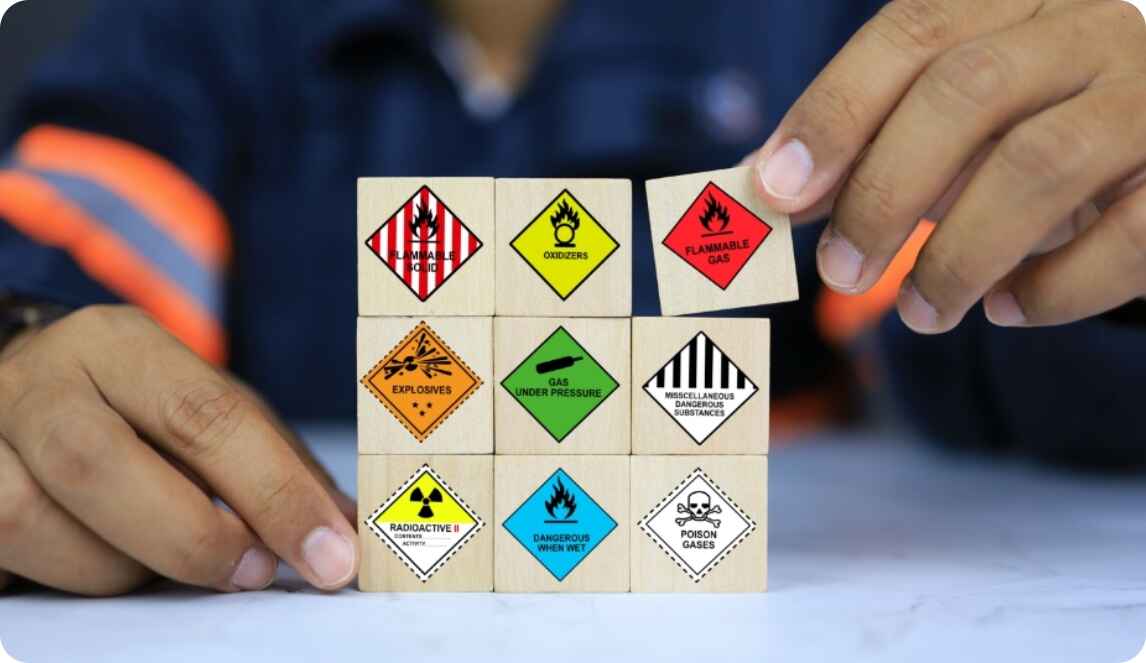Get in touch


Dangerous Goods 101: Guidelines and Protocols
August 01, 2025
Tejan Shirodkar

Modern shipping practices have brought a lot of ease and convenience to the entire world. Goods, regardless of size and type, can be sent to any corner of the world. However, the logistics industry remains as reliable as it is today primarily because of the strict yet efficient protocols and rules that are followed without exception. These include standardized packaging practices, error-free documentation, accurate HS codes, clear handling instructions, and the classification of goods as dangerous or non-dangerous.
For anyone planning to use the services of a logistics partner, understanding these guidelines is essential. Whether you're shipping chemicals, batteries, or aerosols, knowing what qualifies as dangerous goods and how to ship them safely is essential, especially for manufacturers.
From classification and documentation to packaging and safety protocols, this guide will walk you through the essentials and help you understand why choosing a trusted partner like Atlantic International Express can support your global business objectives with confidence and compliance.
Dangerous goods: What are they and how are they classified?
Dangerous goods (DG) are substances or materials that pose risks to health, safety, property, or the environment during transportation. These include:
- Flammable liquids (e.g., paints, solvents)
- Explosives
- Gases (compressed or liquefied)
- Corrosives (acids, alkalis)
- Toxic substances
- Radioactive materials
- Lithium batteries
Each item is classified under a UN number list, a globally recognized system that identifies hazardous materials.
A UN number list provides the official United Nations designations for hazardous substances and articles used in international transport, identifying things like explosives, flammable liquids, or toxic substances. For more info, click here.
Classification: The Nine DG Classes
Understanding the classification is the first step in compliance. Here’s a quick breakdown:
| Class | Type of Hazard | Examples |
|---|---|---|
| 1 | Explosives | Fireworks, ammunition |
| 2 | Gases | Propane, oxygen tanks |
| 3 | Flammable Liquids | Paint, ethanol |
| 4 | Flammable Solids | Matches, magnesium |
| 5 | Oxidizing Substances | Hydrogen peroxide |
| 6 | Toxic & Infectious Substances | Pesticides, medical waste |
| 7 | Radioactive Material | Uranium, medical isotopes |
| 8 | Corrosives | Battery acid, bleach |
| 9 | Miscellaneous | Lithium batteries, dry ice |
Each class has specific handling and packaging requirements, especially when shipping under limited quantity packaging exemptions. You can reach us anytime for any queries. Click here.
Documentation: The process and need-to-knows
When shipping dangerous goods, proper documentation is a legal requirement and a critical safety measure. It ensures that everyone involved in the logistics process, from handlers to customs officials, knows exactly what they're dealing with and how to manage it safely.
Do check out our website to know more. Click here.
The following are the key documents manufacturers must prepare:
-
Material Safety Data Sheet (MSDS)
- MSDS describes the chemical composition, hazards, handling procedures, and emergency measures.
- MSDS classifies the goods and determines packaging and labeling requirements.
- MSDS must be accurate and match the product being shipped.
-
Shipper's Declaration for Dangerous Goods
- A formal statement confirming the nature, classification, and compliance of the shipment.
- Includes the UN number, proper shipping name, hazard class, and packing group.
- Must be signed by a trained and certified individual.
-
UN Number and Proper Shipping Name
-
Packing Instructions and Quantity Limits
-
Transport Documents
- Includes airway bills, bills of lading, and commercial invoices.
- Must reflect the DG classification and match the declaration details.
- Click here.
Proper documentation not only ensures regulatory compliance but also protects your shipment from delays, fines, and other liability. At Atlantic International Express, we assist manufacturers in preparing and verifying all required documents, helping their shipments move smoothly across every border.
Check out our services here and talk to our DG expert today!.
Packaging: Safety Starts Here
Packaging is not just about the appeal but also about safety and control. Dangerous goods must be packed according to international standards (IATA, IMDG, ADR), which include:
- UN-certified containers: Tested for durability and leak prevention.
- Inner and outer packaging: To prevent leaks, spills, or reactions.
- Cushioning and absorbents: Especially for liquids and fragile items.
- Clear labeling: Including hazard symbols, UN number, and handling instructions.
Limited quantity and expected quantity packaging
Selected dangerous goods packed in small quantities (limited quantity) or very small volumes (excepted quantity) pose a lesser risk in transport than the same goods packed in larger volumes. Thus, they qualify for some relief from strict packaging requirements provided that they are packed and marked properly.
This could save considerable packaging costs. For smaller shipments, limited quantity packaging offers a simplified route. But the goods must meet specific thresholds. At Atlantic International Express, we specialize in the same and try our best to categorize your small shipments as limited quantity packaged goods for hassle-free transit. From reliable packaging to final delivery, we have got you covered. Do reach out to us to know more. Click here.
Basic Safety Checklist for DG Shipping.
Before you ship, run through this quick checklist:
- Is the item classified correctly under the UN number list?
- Do you have a current MSDS?
- Is the packaging UN-certified and compliant?
- Are all labels and hazard symbols visible?
- Have you completed the ship's declaration?
- Are you using a trusted DG shipping partner?
Atlantic International Express makes sure all boxes are checked. We provide end-to-end support, from classification to customs clearance, ensuring your shipment is delivered. Visit us to know more .
Box to Border: The Atlantic Way
At Atlantic International Express, we simplify your shipping goals so you can focus on what matters most. Whether you're shipping domestically or across borders, our specialized Dangerous Goods Services are designed for manufacturers who value safety, compliance, and reliability. Your goods are as good as delivered the moment you hand them over to us. It is not a goal but a guarantee. Do reach out to us and let us handle your shipment the Atlantic Way. Click here to know more.
FAQs
We offer shipping services for almost every item as long as it is not prohibited.
Do check out the list of prohibited items here.
We also provide specialized delivery services for dangerous goods, medicines, food items, and documents.
Key documents include the MSDS, Shipper's Declaration for Dangerous Goods, UN number and proper shipping name, packing instructions, and transport documents like airway bills or commercial invoices.
You can refer to the official UN number list or consult your product's MSDS (Material Safety Data Sheet), which typically includes the UN number and hazard classification.
An MSDS (Material Safety Data Sheet) outlines the chemical composition, hazards, and handling instructions of a product. It's essential for proper classification, packaging, and compliance during shipping.
We offer end-to-end support, from classification and documentation to packaging and customs clearance, ensuring your dangerous goods are shipped safely, legally, and efficiently.
You can click here to request a customized quote based on your package size, weight, destination, and other preferences.


